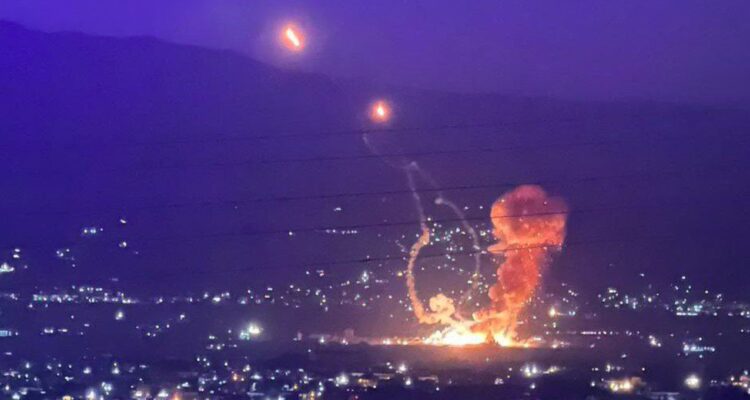The IAF’s preemptive strike against Hezbollah is part of a broader strategy to manage multiple combat fronts in the ongoing conflict.
By Yaakov Lappin, JNS
The Israeli Air Force is systematically degrading Hezbollah’s capabilities while preparing for a full-scale war, according to a former IAF commander.
On Aug. 25, the IAF launched a significant preemptive strike against Hezbollah positions in southern Lebanon, following intelligence that indicated an imminent large-scale missile and rocket attack on Israel.
The operation, executed shortly before dawn, struck thousands of rocket launchers and unmanned aerial vehicles (UAVs) storage sites, with the aim of disrupting the terror organization’s ability to carry out its planned assault.
Former IAF commander Maj. Gen. (res.) Amikam Norkin said during a webinar organized by the Jewish Institute for National Security of America (JINSA) on Aug. 26 that the preemptive strike was meticulously planned in response to concrete intelligence gathered by Israeli security agencies.
“Israeli intelligence recognized that Hezbollah [planned] to act against strategic targets inside Israel,” he stated.
The strike involved around 100 fighter jets striking multiple Hezbollah positions, focusing on rocket launchers and UAV units concealed in open fields and wooded areas.
According to Norkin, the IAF specifically avoided targeting launchers in densely populated areas to minimize the risk of civilian casualties.
Norkin emphasized that the IAF’s actions are carefully calibrated to achieve tactical objectives while avoiding war.
“At the tactical level, I think that we achieved what we planned to achieve,” he said.
While he was unsure that Israel is “at the right level” now in terms of its position against Hezbollah, “We’re in a better situation than compared to a month ago.”
Despite the preemptive strike, Hezbollah still managed to launch some 300 rockets and drones toward northern Israel.
Most were successfully intercepted, said Norkin, including all of the drones launched toward central Israel.
Norkin also pointed out the significance of suicide drones in this conflict, describing them as the “main story” due to their precision and the threat they pose to strategic targets.
The IAF’s preemptive strike against Hezbollah is part of a broader strategy to manage multiple combat fronts in the ongoing conflict, according to Norkin.
Since the outbreak of the war on Oct. 7, the IAF has been engaged not only in Gaza and Lebanon but also in Syria and Yemen.
Israeli warplanes struck Yemen’s Al-Hodeida Port on July 20 in retaliation for a deadly Houthi drone attack on Tel Aviv.
The IAF is also engaged in counter-terror operations in Judea and Samaria.
“Every day in the last 10 months there is high-alert air power that is … waiting for any, let’s say, surprises, on each of the fronts, especially from the northern front,” he said.
This was especially true during the first few months of the war, when “we thought Hezbollah might try to send special forces into Israeli territory,” he added.
Maj. Gen. (ret.) Yaacov Ayish, former Israeli Defense Attaché to the United States, suggested that Hezbollah’s limited retaliation for the assassination of the terror group’s top commander in Beirut last month was a calculated decision influenced by broader strategic considerations.
“Hezbollah has the ability to launch something like 3,000-4,000 rockets a day, but they chose to use only a very limited portion of their power,” he said.
This restraint, according to Ayish, reflects Hezbollah’s and Iran’s desire to avoid triggering a full-scale war.
Israel’s decision to hit launchers that were about to be used by Hezbollah and to remove immediate threats, and to target weapons storage sites, are part of a cumulative Israeli strategy to degrade the terror group’s capabilities “for the day after.”
While Israel, too, seeks to avoid escalating the situation to a full-scale war, its removal of these threats is part of preparations for such a war, “which I’m afraid is imminent,” he said.
Addressing Hezbollah’s actions since Oct. 8, when it joined in the war started by Hamas with its invasion of southern Israel a day earlier, Ayish stated, “We have to ask why they decided to take it to the next level and why in a limited way.”
With over 500 Hezbollah operatives, many of them commanders, having been killed in the conflict so far, the Iran-backed terror army on appears to be balancing its response with the need to preserve its remaining capabilities, and coordinating its actions closely with Tehran.
Ayish highlighted the importance of Israel’s offensive capabilities as the first line of defense, followed by robust systems like the Iron Dome as the second line of defense.





